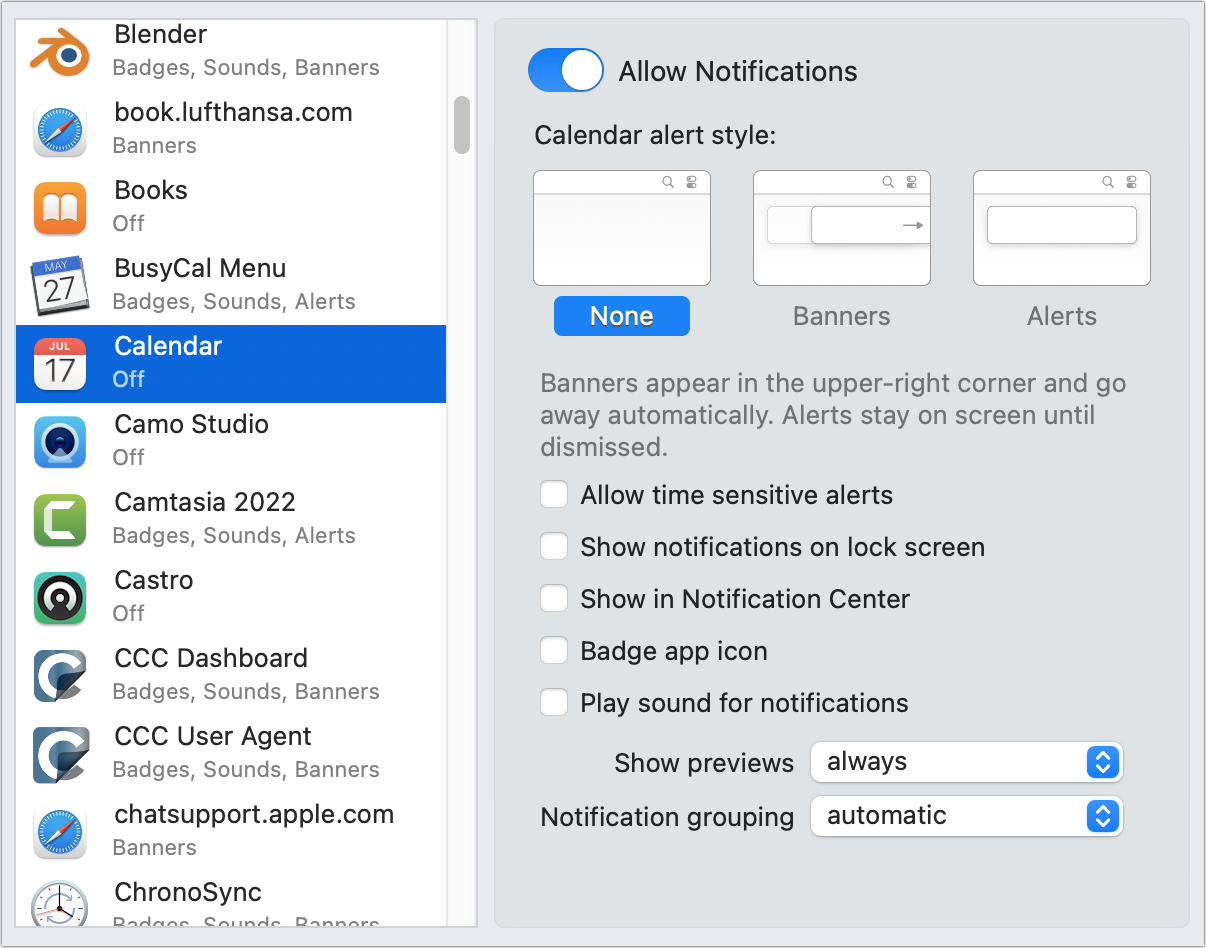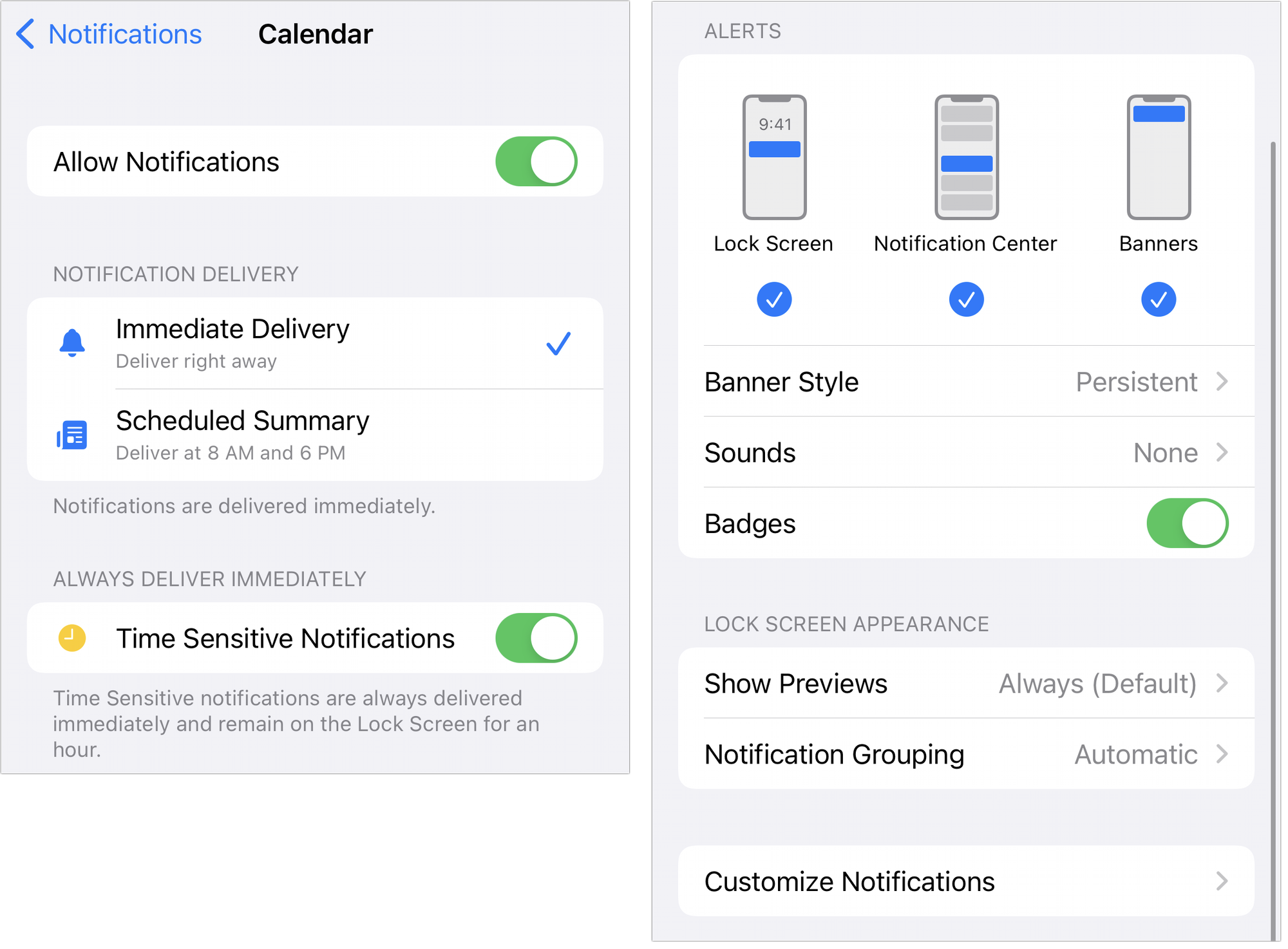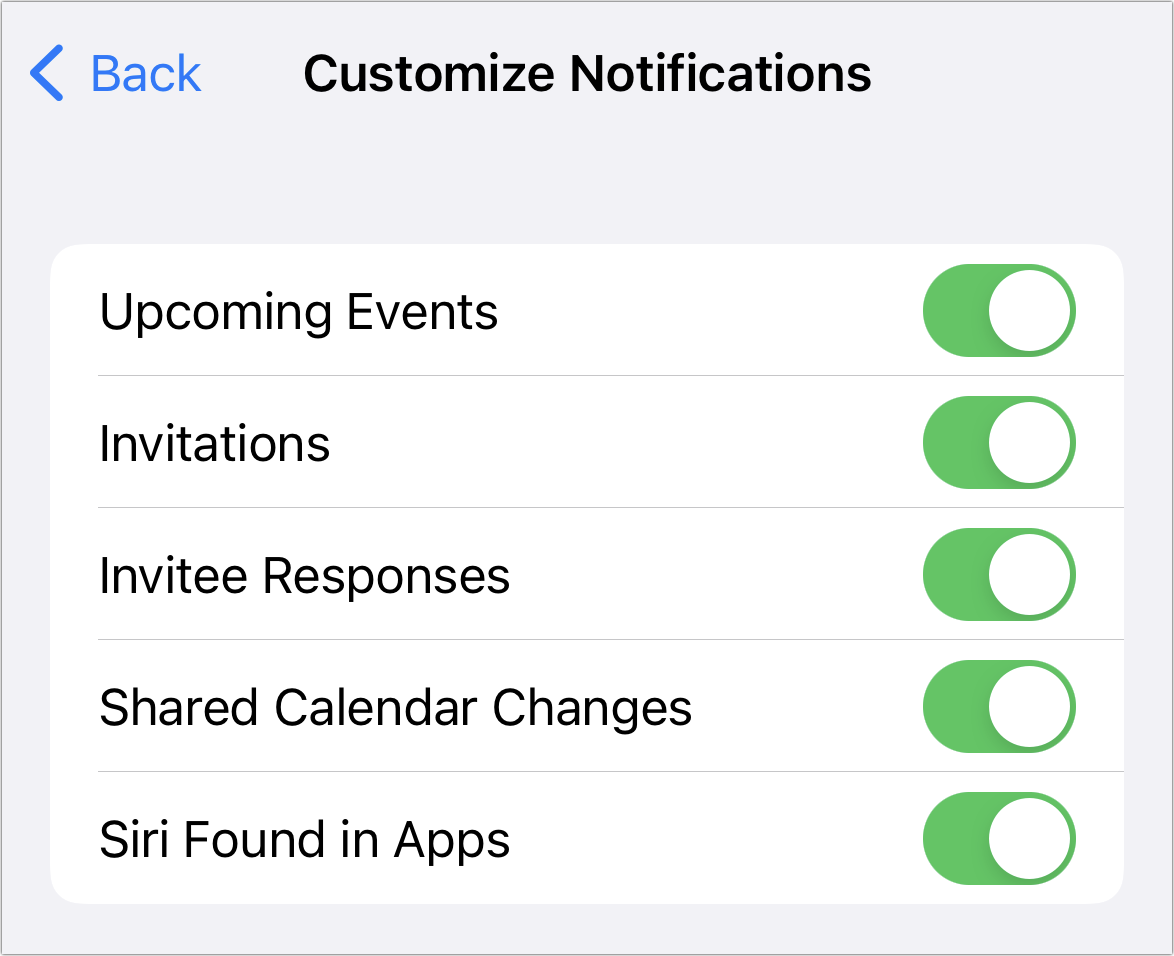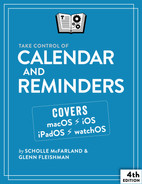Set Up Notifications
What a Calendar or Reminders notification looks like on your Mac, iPhone, iPad, or Apple Watch depends on each device’s Notifications settings. In addition, whether a notification appears in Notification Center depends on the settings. Let’s take a quick look at how you can make your Notifications settings work best for you.
Notifications on Your Mac
What your notifications ultimately look like—and sound like—depends on your system-wide settings for notifications. Let’s first orient you to find them on your version of macOS:
In macOS 11 Big Sur and earlier: Go to System Preferences > Notifications and select Calendar or Reminders in the list on the left to view your options on the right.
In macOS 12 Monterey: Go to System Preferences > Notifications & Focus, click the Notifications tab, and select Calendar or Reminders in the list on the left to view your options on the right.
In macOS 13 Ventura: Go to System Settings > Notifications and, under App Notifications, select Calendar or Reminders.
Figure 48 shows Calendar’s options as they appear in Monterey (the same as Big Sur); Figure 49 shows Calendar’s options as presented in Ventura. Your choices are identical for Reminders.


By default, both Calendar and Reminders notifications are alert style; in other words, they require that you dismiss them (Figure 50).

Hover over an alert-style notification to see what you can do with it. A Close ![]() icon appears at its corner; click this to dismiss the notification. An Options button for Calendar and Reminder alerts offers options to defer:
icon appears at its corner; click this to dismiss the notification. An Options button for Calendar and Reminder alerts offers options to defer:
For Calendar, you can select from a range of 1 minute to 1 week to snooze the notification, or choose “Snooze until end time” to prevent further alerts.
For Reminders, you can select Complete, Remind Me in an Hour, Remind Me A Little Later (This Afternoon and Tonight are two possibilities), or Remind Me Tomorrow.
You can modify notification settings so that a banner appears momentarily and then disappears—you catch it or you don’t. To do so, select Banners. If you prefer no notifications, select None.
Other settings here include:
Show notifications on lock screen: Select this to see the app’s notifications on the Lock screen before you log in to your Mac.
Show in Notification Center: Make sure this is selected if you want to see recent notifications from the app when you Check Notification Center on a Mac.
Badge app icon: Select this to see how many notifications are pending by looking for a red badge on the app’s icon in the Dock.
Play sound for notification(s): Select this to have your notification play a sound. By default, it’s Basso. You can change that for all system responses in System Preferences > Sound > Sound Effects by clicking a different sound (Monterey and earlier) or in System Settings > Sound in the Sound Effects pop-up menu (Ventura). If you’d prefer that your Mac be quiet, uncheck the box.
Show previews: From this pop-up menu, choose “always” if you don’t mind anyone seeing your event or reminder previews. Alternatively, choose “when unlocked” to show these only when you’ve logged in to your Mac. Or, choose “never.” In Ventura, “default” follows your main Notifications settings for Show Previews.
Notification grouping: Notifications appear in the upper-right corner of your screen. Here are your options:
Automatic: This setting groups notifications by app when multiples come in. But it doesn’t seem to affect Calendar or Reminders: for instance, a reminder’s sub-tasks appear separately.
By app: This setting groups notifications together into one expandable alert with the most recent on top.
Off: Notifications appear separately in the order they’re received.
Notifications on Your iPhone and iPad
Your iPhone or iPad has its own settings that affect how notifications display on it. For any notification trigger, such as a calendar event giving you a 5-minute warning or a scheduled reminder coming due, you can generally get as many as three alerts, as follows:
Sound: A sound plays when the notification is triggered.
Banner: Banners can appear on your device’s Lock Screen, in Notification Center, or at the top of your screen.
Badges: Turn this on and a red badge containing a number appears on the Calendar icon in the Home screen; it shows how many notifications you have.
As with Mac notifications, there are three choices for grouping notifications: Automatic, By App, or Off.
To set your Calendar or Reminders notifications, tap Settings > Notifications and select Calendar or Reminders (Figure 51).
For Calendar, you can also tap a subcategory of notification trigger, such as Customize Notifications > Upcoming Events, to see its notification options. Reminders has no subcategories.
To change a category’s notifications, tap it and adjust the switches as follows:
Allow Notifications: Toggle this on if you want this category to include notifications.

Figure 51: Tap an event delivery option (at left), and customize presentation options (at right). (iOS 15 shown.) Notification Delivery: Starting in iOS 15/iPadOS 15, you can set whether you want notifications delivered right away (Immediate Delivery) or in a Scheduled Summary. You can also opt for whether or not a notification that’s considered time sensitive is immediately delivered and retained on the lock screen by enabling that option.
Alerts: Choose from three types of alerts:
Lock Screen: Turn this on to see alerts on the Lock screen. These can be easy to overlook, so don’t rely on them.
Notification Center: To see Calendar or Reminders notifications in your device’s Notification Center, turn this on. (Flip back to Notification Center in iOS and iPadOS for more.)
Banners: Banners appear at the top of your screen, regardless of what you’re doing on your device.
Banner Style: If you set the Banner Style to Persistent, the notification stays on screen until you dismiss it. This is helpful when you don’t want to miss something. However, if you don’t mind if the notifications appear and then disappear, set the Banner Style to Temporary. Use this for lower-priority notifications that you don’t mind missing if you’ve set your device down.
Sounds: You have your choice of 13 built-in alert tones and 29 ringtones here. Tap one for a preview. Tap Tone Store to browse (and possibly purchase) ringtones galore or choose from movie and television-themed sounds.
Badges: Turn this on to see a red badge on the Home screen Calendar or Reminders icon to show how many notifications you have.
Show Previews and Notification Grouping: These two settings work identically as in macOS; see Notifications on Your Mac. Generally, Show Previews controls whether you see a generic identifier (like “Reminders” or “Events”) or the specific text of an event or task. Notification Grouping appears to have little effect on Calendar or Reminders.
Customize Notifications (Calendar only): Calendar has a set of specific switches you can access by tapping Customize Notifications. You can opt to be alerted or not to upcoming events, invitations, invitee responses, shared calendar changes, and if Siri finds calendar entries in apps.
What you see with iOS/iPadOS Calendar and Reminders alerts is what you get. You can’t create a custom alert for a particular event, as you can on a Mac, to override default settings.

Notifications on an Apple Watch
Open the Watch app on your iPhone to set up notifications: tap Notifications > Calendar or Notifications > Reminders. By default, the Apple Watch uses your iPhone’s settings for Calendar and Reminders.
If you prefer, tap Custom and choose different notification settings for the Apple Watch. For instance, you may want to feel a tap on your wrist (haptic) rather than a sound for upcoming events.
